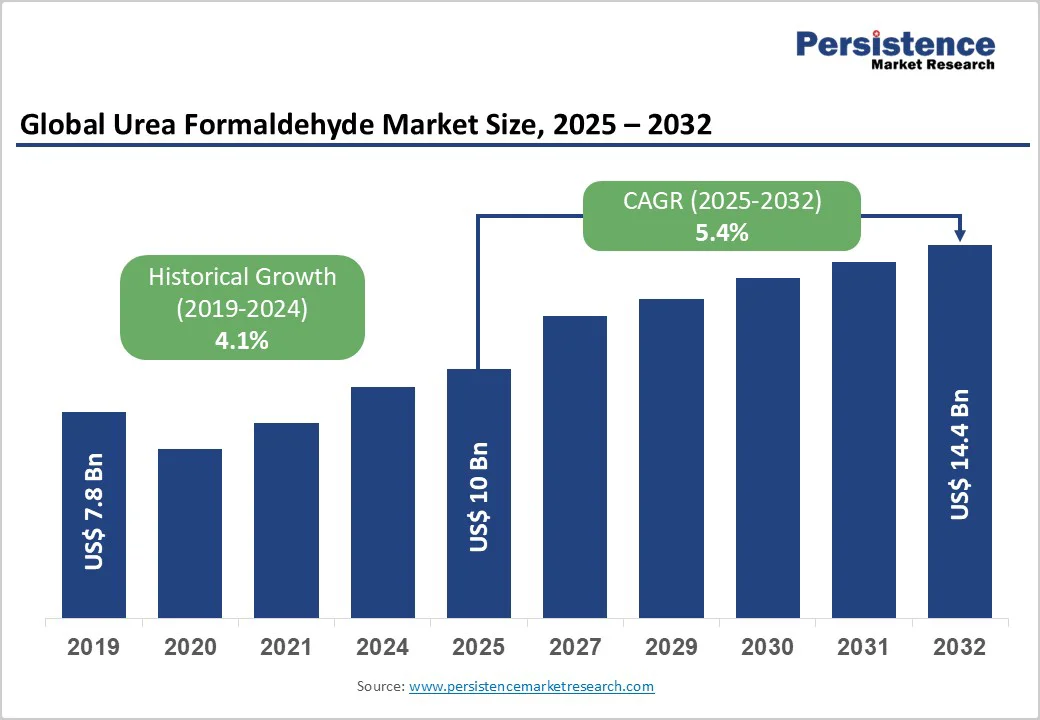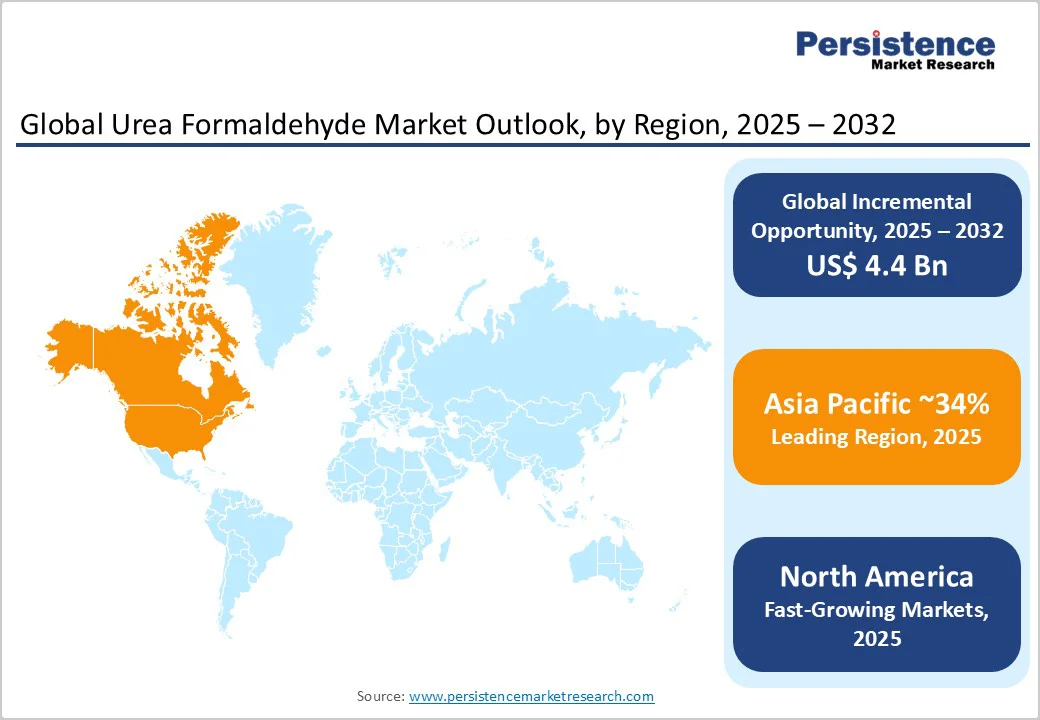ID: PMRREP35801| 183 Pages | 31 Oct 2025 | Format: PDF, Excel, PPT* | Chemicals and Materials

The global urea-formaldehyde (UF) market size is likely to be valued at US$10.0 billion in 2025 and is projected to reach US$14.4 billion by 2032, growing at a CAGR of 5.4% during the forecast period 2025 - 2032.
The demand for UF is driven by the expanding furniture & woodworking and building & construction industries, which are seeking cost-effective adhesives. At the same time, regulatory emphasis on low-emission resins is expected to spur innovation in the formulation of low-free formaldehyde and bio-based UF alternatives, bolstered by rising environmental standards and consumer awareness.
| Key Insights | Details |
|---|---|
| Urea Formaldehyde Market Size (2025E) | US$10.0 Bn |
| Market Value Forecast (2032F) | US$14.4 Bn |
| Projected Growth CAGR (2025 - 2032) | 5.4% |
| Historical Market Growth (2019-2024) | 4.1% |

The global surge in the building and construction industry, driven by rapid urbanization, population growth, and extensive infrastructure investments, has significantly increased demand for urea-formaldehyde resins. These resins are extensively used as adhesives in plywood, particleboard, and fiberboard due to their superior bonding strength, thermal stability, and cost-effectiveness.
Construction spending in emerging economies is widening the consumption of UF resins in residential and commercial projects. Furthermore, government initiatives promoting affordable housing and low-cost construction materials, such as India’s Pradhan Mantri Awas Yojana and China’s urban housing programs, are accelerating the adoption of UF resins.
Formaldehyde, a key component in UF resin production, is classified as a human carcinogen by the World Health Organization (WHO) and several regional health agencies. This has led to stringent regulations governing volatile organic compound (VOC) emissions and product labeling, particularly in North America and Europe. Manufacturers face significant challenges in reformulating traditional UF resins to meet these standards without compromising performance or cost efficiency.
The need for continuous emission testing, certification, and compliance monitoring has increased operational costs; smaller resin producers, in particular, face profitability pressures due to these regulatory burdens. Moreover, growing consumer environmental awareness and the shift toward eco-friendly materials in furniture and building applications further limit UF resin market expansion in regions with strict environmental policies.
The transition toward sustainable chemistry is opening significant growth opportunities for bio-based UF resin alternatives. Continuous R&D efforts have enabled the development of resins derived from renewable sources such as lignin, soy protein, and starch, offering comparable adhesive strength with reduced environmental footprint.
Major chemical companies are investing in collaborative ventures with agricultural biorefineries to ensure consistent bio-feedstock availability and cost stability. As the global bio-adhesives market experiences rapid expansion, urea-formaldehyde resin producers can leverage their technical expertise to diversify their product portfolios and enter emerging green adhesive segments. This strategic shift not only mitigates regulatory risks but also enhances brand positioning among environmentally conscious industries and consumers.
On the other hand, the automotive industry’s evolution toward lightweight, cost-efficient, and sustainable materials presents new opportunities for UF resin applications in interior components. With vehicle production surging worldwide, demand for UF-based composites, paneling, and carpet backings is likely to grow rapidly.
Modified UF resin formulations provide improved heat resistance, dimensional stability, and aesthetic appeal, all vital to modern automotive design. Furthermore, partnerships between UF resin manufacturers and original equipment manufacturers (OEMs) are fostering the development of tailored adhesive solutions that meet stringent automotive performance standards.
Liquid UF resin is currently the dominant product type, accounting for approximately 45% of the urea formaldehyde market revenue share in 2025. Its widespread use is driven by its ease of handling, rapid curing properties at ambient temperatures, and compatibility with large-scale industrial application methods such as spray and roll-coating processes.
The growth of liquid UF formulations is primarily fueled by extensive utilization in engineered wood applications, including board lamination and textile treatments. The balance of performance, cost efficiency, and processing flexibility offered by liquid UF resin makes it the preferred choice for manufacturers seeking to optimize production throughput without compromising adhesive quality.
Liquid UF resins often incorporate features such as low emissions and enhanced bonding capabilities, supporting regulatory compliance and meeting evolving customer demands.
Powder resin holds the largest market share, around 50% as of 2025. The preference for powder UF resin stems from its superior storage stability, which significantly extends shelf life compared to liquid alternatives. Furthermore, powder forms reduce transportation costs by eliminating the risks and logistics complications associated with liquid handling, such as spillage and evaporation.
These factors make powder resin the material of choice in molding compound manufacturing, where precise formulation control and batch consistency are critical. The growing demand for high-quality, moisture-resistant molded products in automotive, electrical, and industrial markets is projected to maintain the powder resin's dominant position, supported by ongoing formulation innovations enhancing product performance and environmental profiles.
The adhesives & binders segment is estimated to hold 55% market share in 2025. Adhesives and binders benefit from UF resin’s strong bonding characteristics, fast curing rates, and economic advantages, driving substantial adoption in the production of plywood, medium-density fiberboard (MDF), and particleboard. The steady growth of this segment is driven by rising demand for urea-formaldehyde in the construction and furniture manufacturing industries.
The segment's expansion is also driven by technological advancements, including low-formaldehyde formulations that align with stricter environmental regulations and green building standards. These factors collectively reinforce the dominance of adhesives and binders, cementing UF resins as a cornerstone for cost-effective, high-performance bonding solutions in engineered wood applications.
North America is anticipated to lead the urea formaldehyde market share in 2025, driven by stringent formaldehyde emissions regulations under the U.S. Environmental Protection Agency (EPA) and a robust housing sector.
Investment in low-emission UF technologies has accelerated, with major producers establishing regional R&D centers. Meanwhile, Canada’s emphasis on green building certifications boosts the adoption of bio-based UF alternatives, encouraging collaborative programs between resin suppliers and construction firms.
Industrial innovation ecosystems in California and Texas foster pilot-scale production of advanced UF formulations that integrate next-generation curing catalysts. Government incentives for sustainable materials research have financed over US$50 billion in grants from 2022 to 2025, reinforcing the region’s leadership in low-impact UF resin development.
In Europe, regulatory harmonization under REACH is stimulating the adoption of ultra-low formaldehyde resins, with manufacturers investing in automated production lines to maintain compliance. France and the U.K. are focusing on energy-efficient UF resin processes, seeking to reduce CO2 emissions per ton of resin produced.
Moreover, collaboration among European Union (EU) member states on circular economy initiatives has promoted recycling of wood composites, indirectly boosting UF resin demand for re-bonding applications. Regulatory frameworks across Europe prioritize worker safety and environmental impact, accelerating the shift toward low-free formaldehyde resin in decorative laminates and floorings.
China leads the Asia Pacific market, driven by its massive furniture and textile manufacturing sectors, which together account for over 50% of regional UF resin consumption. Rapid urbanization in India has spurred demand for low-cost housing, elevating UF resin use in particleboard and plywood. ASEAN countries leverage favorable raw material availability and lower production costs, fostering investment in new UF resin plants.
Japan’s focus on high-performance modified resins for electrical insulation has been strengthening, with significant annual expansions in production capacity. Regional manufacturers benefit from government-backed R&D grants exceeding US$20 billion between 2021 and 2024 to develop bio-based alternatives, bolstering the position of the Asia Pacific in sustainable urea formaldehyde technologies.

The global urea-formaldehyde market exhibits a moderately consolidated structure, with key players such as BASF SE, Hexion, and Acron PJSC commanding significant market share through expansive product portfolios and global distribution networks.
Companies pursue capex investments in low-emission resin lines and strategic partnerships with raw material suppliers. Innovation in catalyst systems and green chemistry serves as a key differentiator. At the same time, emerging business models focus on licensing of proprietary resin formulations to local producers, enhancing market reach and flexibility.
The global urea formaldehyde (UF) market is projected to reach US$ 10.0 billion in 2025.
The massive expansion of the building & construction sector, fueled by unprecedented urbanization and large-scale infrastructure projects, is the primary market driver.
The market is poised to witness a CAGR of 5.4% from 2025 to 2032.
Developing bio-based UF alternatives via partnerships with agricultural biorefineries presents the most significant growth opportunity.
BASF SE, Hexion, and Acron PJSC are few of the key market players.
| Report Attributes | Details |
|---|---|
| Historical Data/Actuals | 2019 - 2024 |
| Forecast Period | 2025 - 2032 |
| Market Analysis Units | Value: US$ Bn, Volume: As Applicable |
| Geographical Coverage |
|
| Segmental Coverage |
|
| Competitive Analysis |
|
| Report Highlights |
|
By Product Type
By Form
By Application
By Region
Delivery Timelines
For more information on this report and its delivery timelines please get in touch with our sales team.
About Author